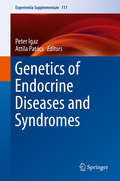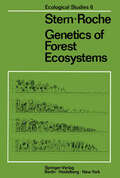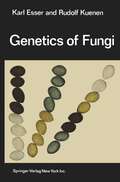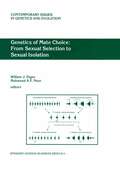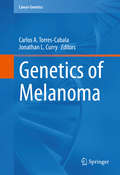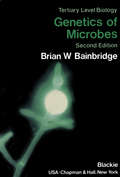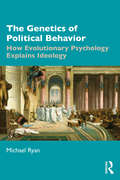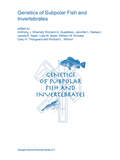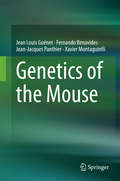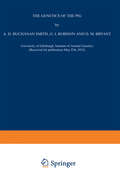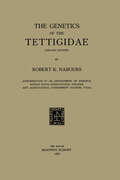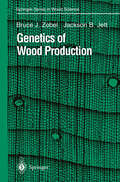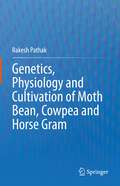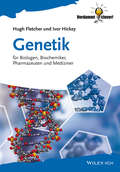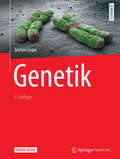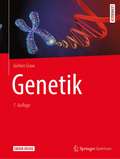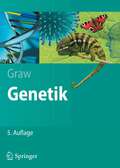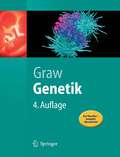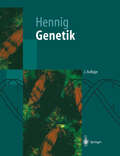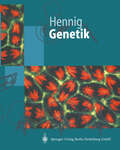- Table View
- List View
Genetics of Endocrine Diseases and Syndromes (Experientia Supplementum #111)
by Peter Igaz Attila PatócsThis book provides a comprehensive overview of the genetic basis underlying endocrine diseases. It covers both the molecular and clinical consequences of these genetic defects, as well as the relevance for clinical care, highlighting issues of genetic counseling. Several endocrine diseases have a genetic background, and contemporary research in the field plays a crucial role in the clinical care of endocrine diseases. In recent years, there have been major developments in our understanding of the genetic basis of endocrine diseases. Several novel genes and mutations predisposing individuals to monogenic endocrine diseases have been discovered, and with the advent of next generation sequencing, a huge amount of new data has become available. Further, novel molecular mechanisms, such as genomic imprinting, have been implicated in the pathogenesis of endocrine diseases.A better understanding of the genetic background of these diseases is relevant not only from the research perspective, but also in terms of clinical care. As such, this book is an essential read for both researchers and clinicians working in the field.
Genetics of Forest Ecosystems (Ecological Studies #6)
by K. Stern L. RocheThroughout the world natural forest ecosystems have been, and are being massively disrupted or destroyed. The boreal forests of Canada are no more immune to man's intervention than the tropical rain forests of Africa, and the day is rapidly approaching when natural forest ecosystems, undisturbed by man, will be found only as remnants in national parks and other protected areas. Yet where they continue to exist these ecosystems are an extraordinarily rich, though relatively neglected source of data that illuminate many aspects of the classic theory of evolution. The subject matter of this book is not, however, confined to natural forest ecosystems. Forest ecosystems under varying degrees of management, and man made forests are also a rich source of information on ecological genetics. In general, however, it can be said that the published evidence of this fact has not yet significantly penetrated the botanical literature. All too frequently it is confined to what might be termed forestry journals. It is hoped that this book will to some extent redress the balance, and draw attention to a body of published work which not only provides a basis for the rational management and conservation of forest ecosystems, but also complements the literature of ecological genetics and evolution. The first draft of Chapters I to V was written in German by the senior author and translated by E. K. MORGENSTERN of the Canadian Forestry Service.
Genetics of Fungi
by Karl Esser R. KuenenThe significance of genetics in biology today stems to a considerable extent from the knowledge which has been obtained through the use of fungi as experimental objects. As a result of their short generation time, their ease of culture under laboratory conditions, and the possibil ity of identifying the four products of meiosis through tetrad analysis, the fungi have proven themselves in many ways superior to the classic genetic experimental material such as Drosophila and maize. Because they permit investigation of genetic fine structure as well as biochemical analysis of the function of the genetic material, the fungi can be used, just as the bacteria and bacteriophages, for molecular biological research. Further, the fungi, because of their simple organi zation, are suitable for investigation of the genetic and physiological bases of morphogenesis and of extrachromosomal inheritance. This monograph is an attempt to summarize and interpret the results of genetic research on fungi. The reader should be reminded that review and interpretation of original research are inevitably influenced by the authors' own opinions. An understanding of the basic principles of genetics is assumed.
Genetics of Mate Choice: From Sexual Selection to Sexual Isolation (Contemporary Issues in Genetics and Evolution #9)
by W. J. Etges M. A. NoorGenetic studies aimed at understanding the origin of species are dominating major scientific journals. In the past decade, genetic tools that were previously available only in model systems have become accessible to investigators working on nearly all species. Concurrent with these technical advances has been an increase in understanding of both the importance of considering the ecological context of speciation and testing hypotheses about causes for species formation. Many recent studies suggest a prominent role of sexual selection in species formation. These advances have produced a need for a synthesis of what we now understand about speciation, and perhaps more importantly, where we should go from here. In this volume, several leading investigators and rising stars have contributed reviews and/or novel primary research findings aimed at understanding the ultimate mystery on which Darwin named his most famous and influential book. Fundamental to the origin of species is the evolution of mate choice systems. This collection of papers discusses burgeoning genetic, evolutionary, and ecological approaches to understanding the origins of mating discrimination and causes of premating reproductive isolation both within and between species. The individual contributions span a wide spectrum of disciplines, taxa, and ideas (some controversial). This synthesis brings together several of the most recent ideas with supporting empirical data. This book will be of particular interest to both undergraduate and postgraduate researchers and students and researchers in the field of evolutionary biology, genetics and animal behaviour.
Genetics of Melanoma (Cancer Genetics)
by Carlos A. Torres-Cabala Jonathan L. CurryThis book discusses the molecular, biological, pathological, and clinical aspects of melanoma, with special emphasis in the new concepts of melanoma genetics. A multidisciplinary group of experts in Genetics, Dermatology, Pathology, and Melanoma Medical Oncology contribute state-of-the-art knowledge in melanoma research and clinical management, not only exposing the current status of knowledge of the topics but also providing their personal experiences and ideas about the future and potential practical application of the genetic aspects of melanoma. During the last few years we have witnessed an impressive amount of discoveries in the field of melanoma genetics which have changed our approach in understanding the pathogenesis and treatment of this lethal disease. Genetics of Melanoma is a practical approach to melanoma genetic mechanisms and their application in the diagnosis and treatment of this malignancy. It is an essential source of updated information and a powerful tool for clinicians, pathologists, and basic scientists who wish to understand, apply, and investigate the multiple new aspects of melanoma genetics.
Genetics of Microbes (Tertiary Level Biology)
by Brian W. BainbridgeWriting a textbook on microbial genetics in about 200 pages was un doubtedly a difficult task, but I have been encouraged by the response from both students and lecturers to the first edition. The requirement for a second edition is also a measure of the need for such a book. My experience as a lecturer has shown that what is needed first is an intelligible framework which can be read in a reasonable period of time. Armed with these principles, a student can then go to reviews and the original literature with a reasonable chance of understanding the jargon and the details. Molecular genetics is now so well advanced that it is easy to lose track of the purpose of a set of experiments in the wealth of sequence data and complex interactions. I have therefore kept the same format for this edition with a well-illustrated text giving original papers, popular reviews, monographs and detailed reviews to enable the student to take the subject further as required.
The Genetics of Political Behavior: How Evolutionary Psychology Explains Ideology
by Michael RyanIn this unique amalgam of neuroscience, genetics, and evolutionary psychology, Ryan argues that leftists and rightists are biologically distinct versions of the human species that came into being at different moments in human evolution. The book argues that the varying requirements of survival at different points in history explain why leftists and rightists have anatomically different brains as well as radically distinct behavioral traits. Rightist traits such as callousness and fearfulness emerged early in evolution when violence was pervasive in human life and survival depended on the fearful anticipation of danger. Leftist traits such as pro-sociality and empathy emerged later as environmental adversity made it necessary for humans to live in larger social groups that required new adaptive behavior. The book also explores new evolutionary theories that emphasize the role of the environment in shaping not only human political behavior but also humans' genetic architecture. With implications for the future of politics, the book explores how the niche worlds we build for ourselves through political action can have consequences for the evolution of the species. Proposing a new way of understanding human politics, this is fascinating reading for students and academics in psychology, the social sciences, and humanities, as well as general readers interested in political behavior.
The Genetics of Political Behavior: How Evolutionary Psychology Explains Ideology
by Michael RyanIn this unique amalgam of neuroscience, genetics, and evolutionary psychology, Ryan argues that leftists and rightists are biologically distinct versions of the human species that came into being at different moments in human evolution. The book argues that the varying requirements of survival at different points in history explain why leftists and rightists have anatomically different brains as well as radically distinct behavioral traits. Rightist traits such as callousness and fearfulness emerged early in evolution when violence was pervasive in human life and survival depended on the fearful anticipation of danger. Leftist traits such as pro-sociality and empathy emerged later as environmental adversity made it necessary for humans to live in larger social groups that required new adaptive behavior. The book also explores new evolutionary theories that emphasize the role of the environment in shaping not only human political behavior but also humans' genetic architecture. With implications for the future of politics, the book explores how the niche worlds we build for ourselves through political action can have consequences for the evolution of the species. Proposing a new way of understanding human politics, this is fascinating reading for students and academics in psychology, the social sciences, and humanities, as well as general readers interested in political behavior.
Genetics of Subpolar Fish and Invertebrates (Developments in Environmental Biology of Fishes #23)
by Anthony J. Gharrett Richard G. Gustafson Jennifer L. Nielsen James E. Seeb Lisa W. Seeb William W. Smoker Gary H. Thorgaard Richard L. WilmotFisheries genetics researchers will find invaluable the thirty-eight peer-reviewed contributions in this book, presented at the 20th Lowell Wakefield Fisheries Symposium "Genetics of Subpolar Fish and Invertebrates," held in May 2002 in Juneau, Alaska. Looming over concerns of lost fisheries stocks and persistent erosion of genetic variability are predictions of global warming, which may further tax genetic resources. One consequence is an increased reliance on genetic applications to many aspects of fisheries management, aquaculture, and conservation. The contributions in this book are important to modern fisheries science and genetics, and illustrate the evolution of the field over the past decade. The improved technology provides tools to address increasingly complicated problems in traditional applications and ecological and behavioral studies. The union between molecular and quantitative genetics, where many of the major questions about population structure and evolution remain unanswered, will also benefit from the new technologies.
Genetics of the Mouse
by Jean Louis Guénet Fernando Benavides Jean-Jacques Panthier Xavier MontagutelliThis book, written by experienced geneticists, covers topics ranging from the natural history of the mouse species, its handling and reproduction in the laboratory, and its classical genetics and cytogenetics, to modern issues including the analysis of the transcriptome, the parental imprinting and X-chromosome inactivation. The strategies for creating all sorts of mutations, either by genetic engineering or by using mutagens, are also reviewed and discussed in detail. Finally, a last chapter outlines the methodology used for the analysis of complex or quantitative traits. The authors also discuss the importance of accurate phenotyping, which is now performed in the mouse clinics established worldwide and identify the limits of the mouse model, which under certain circumstances can fail to present the phenotype expected from the cognate condition in the human model. For each chapter an up-to-date list of pertinent references is provided. In short, this book offers an essential resource for all scientists who use or plan to use mice in their research.
Genetics of tongue rolling (Large Print)
by Rnib BookshareThis image shows the genetics involved in determining whether offspring will be able to roll their tongue or not. There is a locator dot shown, which will be at the top left of the page when the image is the right way up. This is depicted as a box divided equally into four sections making up a matrix, and each section represents an offspring. The labels to the left of the box show the fathers alleles (recessive at the top, dominant at the bottom), and the labels above the box shows the mothers alleles (dominant on the left, recessive on the right), as listed in the key at the bottom of the page. Reading from this matrix, one allele from the mother and the father go to each one of four offspring. The offspring are: Dr can roll tongue (top left), rr cant roll tongue (top right) DD can roll tongue (bottom left), Dr can roll tongue (bottom right)
Genetics of tongue rolling (UEB Contracted)
by Rnib BookshareThis image shows the genetics involved in determining whether offspring will be able to roll their tongue or not. There is a locator dot shown, which will be at the top left of the page when the image is the right way up. This is depicted as a box divided equally into four sections making up a matrix, and each section represents an offspring. The labels to the left of the box show the fathers alleles (recessive at the top, dominant at the bottom), and the labels above the box shows the mothers alleles (dominant on the left, recessive on the right), as listed in the key at the bottom of the page. Reading from this matrix, one allele from the mother and the father go to each one of four offspring. The offspring are: Dr can roll tongue (top left), rr cant roll tongue (top right) DD can roll tongue (bottom left), Dr can roll tongue (bottom right)
Genetics of tongue rolling (UEB Uncontracted)
by Rnib BookshareThis image shows the genetics involved in determining whether offspring will be able to roll their tongue or not. There is a locator dot shown, which will be at the top left of the page when the image is the right way up. This is depicted as a box divided equally into four sections making up a matrix, and each section represents an offspring. The labels to the left of the box show the fathers alleles (recessive at the top, dominant at the bottom), and the labels above the box shows the mothers alleles (dominant on the left, recessive on the right), as listed in the key at the bottom of the page. Reading from this matrix, one allele from the mother and the father go to each one of four offspring. The offspring are: Dr can roll tongue (top left), rr cant roll tongue (top right) DD can roll tongue (bottom left), Dr can roll tongue (bottom right)
Genetics of Wood Production (Springer Series in Wood Science)
by Bruce J. Zobel Jackson B. JettOver the past years, a great deal has been learned about variation in wood prop erties. Genetic control is a major source of variation in most wood properties. Wood is controlled genetically both directly in the developmental or internal pro cesses of wood formation and indirectly by the control of tree form and growth patterns. Emphasis in this book will be on the internal control of wood production by genetics although there will be two chapters dealing with the indirect genetic control of wood, which was covered in detail in the previous book by Zobel and van Buijtenen (1989). The literature on the genetics of wood is very variable, SO'lle quite superficial, on which little reliance can be placed, and some from well-designed and correctly executed research. When suitable, near the end of each chapter, there will be a summary with the authors' interpretation of the most important information in the chapter. The literature on the genetics of wood can be quite controversial. This is to be expected, since both the environment and its interaction with the genotype of the tree can have a major effect on wood properties, especially when trees of similar genotypes are grown under widely divergent conditions. Adding to the confusion, studies frequently have been designed and analyzed quite differently, resulting in conflicting assessments of results.
Genetics, Physiology and Cultivation of Moth Bean, Cowpea and Horse Gram
by Rakesh PathakThis authored book gives insight into the morphology, physiology, genetics, plant protection and biotechnology of three important arid legumes, viz., moth bean, cowpea and horse gram. There are seven chapters for each crop that provide in-depth information on cultivation, genetic improvement, plant protection measures, management of physiological and abiotic stresses along with related genetic markers and biotechnological advances pertaining to these legumes. The chapters present research findings and brief reviews concerning the advances made in the improvement of these legumes.Legumes are utilized as pulses or grains aiding as an important source of protein for both human and animal consumption and also provide raw materials to the food and feed industries. They are also valuable for soil building, improving soil quality and biological nitrogen fixation. Physiology and genetics provide an inimitable source of information on the distinct aspects of basic and applied legume research for general readers, students, academicians and researchers. Arid legumes are crops characterized by inherent features and capabilities to withstand adverse and harsh climatic conditions, significantly replenish the soil, as well as provide protein and micronutrients. Adaptability to several stresses including drought makes them key to agriculture in areas receiving scanty rainfall. This comprehensive book disseminates significant information on the genetic diversity, cultivation, manipulation through mutagenic techniques, molecular biology and other breeding techniques. The book, therefore, is of importance to teachers, researchers and policymakers who are interested to acquire knowledge about moth bean, cowpea and horse gram. It also serves as an additional reading material for MSc and PhD students of agriculture and environmental sciences. The book is also useful to national and international agricultural scientists and policymakers.
Genetik: für Biologen, Biochemiker, Pharmazeuten und Mediziner (Verdammt clever!)
by Hugh Fletcher Ivor Hickey Claudia HorstmannKompakt und »verdammt clever« auf den Punkt gebracht – vermittelt Genetik das unverzichtbare molekulare Grundwissen sowie alles Wichtige zu den Themen Genome, Mechanismen der Vererbung, Humangenetik, Populationsgenetik und Evolution sowie zu den Anwendungen der modernen Genetik. Das ideale Einsteiger-Buch – verständlicher Text, einprägsame Abbildungen und präzise Kapitelzusammenfassungen sind echte Pluspunkte, wenn es um einen schnellen Start in dieses spannende Fach geht. • Das perfekte Kurzlehrbuch! Optimal für eine Einführung in die molekulare Genetik – die wirklich wichtigen Themen werden mit ihren Kernaussagen kurz und knapp behandelt. • Verständliche Darstellung! Jedes Kapitel enthält eine Zusammenfassung der wesentlichen Fakten und Begriffe, klare und leicht erfassbare Abbildungen illustrieren die Inhalte. • Ohne Angst in die Prüfung! Der Textaufbau ermöglicht strukturiertes Lernen und schnelles Wiederholen – zusätzlich mit über 70 Fragen und Antworten zum Üben.
Genetik: für Biologen, Biochemiker, Pharmazeuten und Mediziner (Verdammt clever!)
by Hugh Fletcher Ivor Hickey Claudia HorstmannKompakt und »verdammt clever« auf den Punkt gebracht – vermittelt Genetik das unverzichtbare molekulare Grundwissen sowie alles Wichtige zu den Themen Genome, Mechanismen der Vererbung, Humangenetik, Populationsgenetik und Evolution sowie zu den Anwendungen der modernen Genetik. Das ideale Einsteiger-Buch – verständlicher Text, einprägsame Abbildungen und präzise Kapitelzusammenfassungen sind echte Pluspunkte, wenn es um einen schnellen Start in dieses spannende Fach geht. • Das perfekte Kurzlehrbuch! Optimal für eine Einführung in die molekulare Genetik – die wirklich wichtigen Themen werden mit ihren Kernaussagen kurz und knapp behandelt. • Verständliche Darstellung! Jedes Kapitel enthält eine Zusammenfassung der wesentlichen Fakten und Begriffe, klare und leicht erfassbare Abbildungen illustrieren die Inhalte. • Ohne Angst in die Prüfung! Der Textaufbau ermöglicht strukturiertes Lernen und schnelles Wiederholen – zusätzlich mit über 70 Fragen und Antworten zum Üben.
Genetik: Die Abbildungen Des Buches (Springer-Lehrbuch)
by Jochen GrawVon Mendel bis zu Genomforschung und Gentechnologie reicht dieses Standardwerk der Genetik. In der 6. Auflage um ein Kapitel zur Epigenetik und um Fragen und Antworten ergänzt sowie aktualisiert, bietet dieses Lehrbuch eine umfassende Darstellung der klassischen und der molekularen Genetik. Cytogenetik, Entwicklungsgenetik, Humangenetik und Anthropologie sowie Neuro- und Verhaltensgenetik sind weitere wichtige Inhalte. Technikboxen bereichern das umfassende Themen- und Methodenspektrum des Buches. Dieses Buch vermittelt genetisches Grundlagenwissen für das gesamte Studium. Dabei unterstützen zahlreiche hervorgehobene Lernhilfen und Beispiele aus allen Bereichen der Genetik sowie farbige Abbildungen.
Genetik
by Jochen GrawVon Mendel bis zu Genomforschung und Gentechnologie reicht dieses Standardwerk der Genetik. Es ist klar strukturiert und bietet eine umfassende Darstellung der klassischen und der molekularen Genetik. Cytogenetik, Entwicklungsgenetik, Humangenetik und Anthropologie sowie Neuro- und Verhaltensgenetik sind weitere wichtige Inhalte. Komplexe Sachverhalte werden verständlich und auf dem aktuellen wissenschaftlichen Stand dargestellt. Technikboxen bereichern das umfassende Themen- und Methodenspektrum. Dieses Buch vermittelt genetisches Grundlagenwissen für das gesamte Studium. Dabei unterstützen zahlreiche hervorgehobene Lernhilfen und Beispiele aus allen Bereichen der Genetik, ansprechende, farbige Abbildungen sowie Übungsfragen. Die 7. Auflage wurde gründlich überarbeitet und aktualisiert sowie mit Links zu erklärenden Videos zu besonderen Aspekten des jeweiligen Kapitels ergänzt.
Genetik (Springer-Lehrbuch)
by Jochen GrawDer Band bietet eine umfassende und präzise Darstellung der klassischen wie der modernen Genetik: Entwicklungsbiologie und –genetik, Humangenetik, Neuro- und Verhaltensgenetik sowie Chromosomenforschung. Für die 5. Auflage wurde das Lehrbuch grundlegend überarbeitet und aktualisiert. Es beinhaltet das Grundlagenwissen der Genetik für das gesamte Studium. Die Inhalte werden durch zahlreiche Lernhilfen und Beispiele aus allen Bereichen der Genetik vermittelt. Alle Abbildungen sind im Internet frei verfügbar.
Genetik (Springer-Lehrbuch)
by Jochen GrawGrundlegend überarbeitet und aktualisiert bietet dieses Lehrbuch in der 4. Auflage eine umfassende Darstellung der klassischen und der molekularen Genetik, von Mendel bis zu Genomforschung und Gentechnologie.
Genetik (Springer-Lehrbuch)
by Wolfgang HennigAktuell überarbeitet und erweitert bietet der "Hennig" eine umfassende Darstellung der klassischen und molekularen Genetik von den Mendelschen Regeln über die Chromosomenforschung bis hin zur Entwicklungsbiologie, Humangenetik und Gentechnologie: Genetisches Grundlagenwissen für das gesamte Studium. Ein neues Kapitel zum Thema Human Genom Forschung erweitert das aktuelle Themen- und Methodenspektrum des Buches. Die Kapitel zu Humangenetik und Gentechnologie wurden mit Hinblick auf den aktuellen Wissensstand überarbeitet und ergänzt. Die Inhalte werden durch zahlreiche hervorgehobene Lernhilfen und Beispiele aus allen Bereichen der Genetik optimal vermittelt. Ausführliche Literaturangaben ermöglichen den Zugang auch zu Originalarbeiten.
Genetik (Springer-Lehrbuch)
by Wolfgang HennigWas ist Genetik? Wer in die Thematik einsteigen möchte, findet hier die Antwort. Ausführlich und aktuell werden Grundlagen und Zusammenhänge, Fakten und Trends beschrieben. Verständlich und anschaulich sind die Informationen zusammengestellt. Durchgehend vierfarbige, lerngerecht gestaltete Seiten mit zahlreichen Abbildungen bieten nicht nur fundiertes Wissen, sondern reines Lesevergnügen. Concise text: Was ist Genetik? Ausführlich und aktuell werden Grundlagen und Zusammenhänge, Fakten und Trends beschrieben. Die anschauliche Darstellung bietet nicht nur fundiertes Wissen, sondern reines Lesevergnügen.
